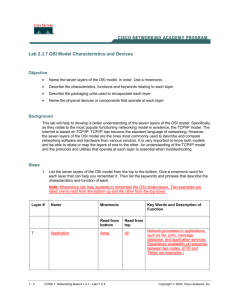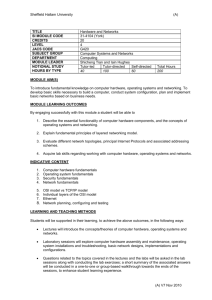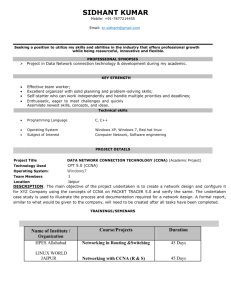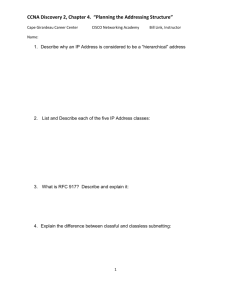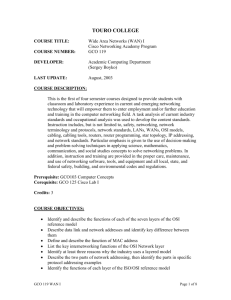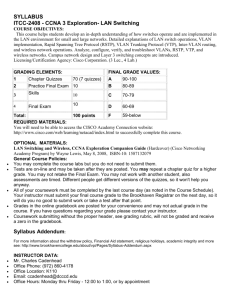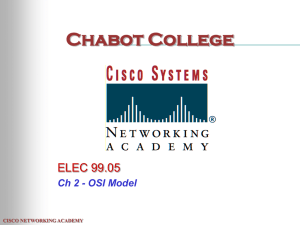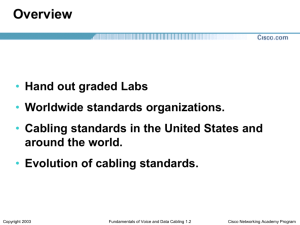II. NUMBER OF TIMES COURSE MAY BE TAKEN FOR CREDIT: Two
advertisement
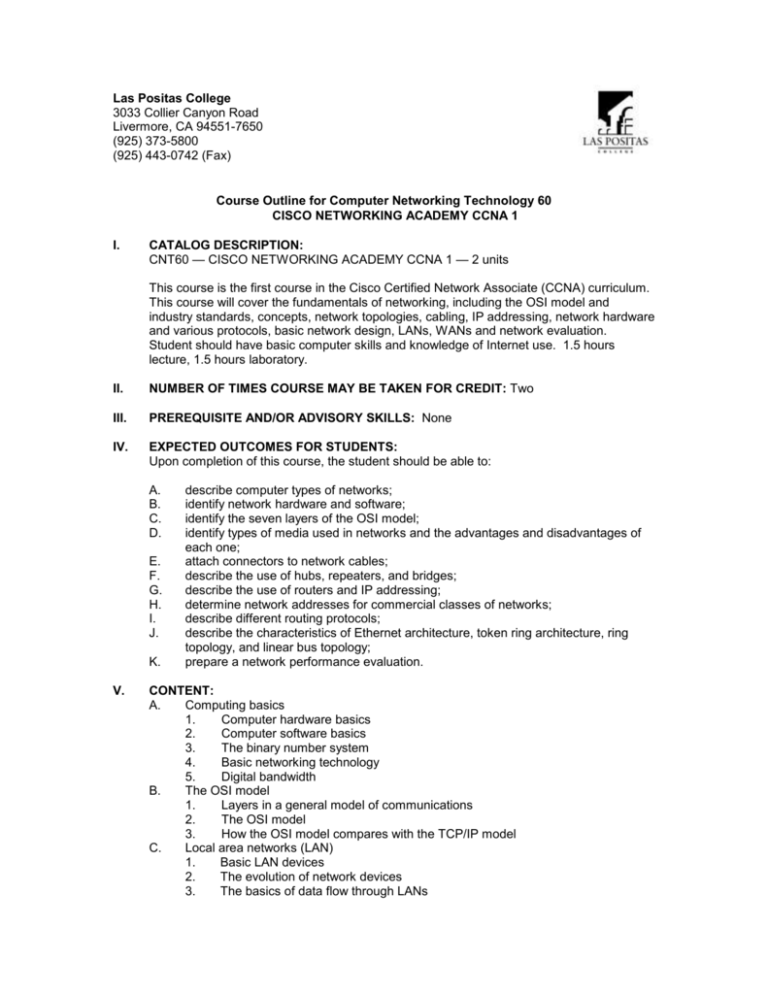
Las Positas College 3033 Collier Canyon Road Livermore, CA 94551-7650 (925) 373-5800 (925) 443-0742 (Fax) Course Outline for Computer Networking Technology 60 CISCO NETWORKING ACADEMY CCNA 1 I. CATALOG DESCRIPTION: CNT60 — CISCO NETWORKING ACADEMY CCNA 1 — 2 units This course is the first course in the Cisco Certified Network Associate (CCNA) curriculum. This course will cover the fundamentals of networking, including the OSI model and industry standards, concepts, network topologies, cabling, IP addressing, network hardware and various protocols, basic network design, LANs, WANs and network evaluation. Student should have basic computer skills and knowledge of Internet use. 1.5 hours lecture, 1.5 hours laboratory. II. NUMBER OF TIMES COURSE MAY BE TAKEN FOR CREDIT: Two III. PREREQUISITE AND/OR ADVISORY SKILLS: None IV. EXPECTED OUTCOMES FOR STUDENTS: Upon completion of this course, the student should be able to: A. B. C. D. E. F. G. H. I. J. K. V. describe computer types of networks; identify network hardware and software; identify the seven layers of the OSI model; identify types of media used in networks and the advantages and disadvantages of each one; attach connectors to network cables; describe the use of hubs, repeaters, and bridges; describe the use of routers and IP addressing; determine network addresses for commercial classes of networks; describe different routing protocols; describe the characteristics of Ethernet architecture, token ring architecture, ring topology, and linear bus topology; prepare a network performance evaluation. CONTENT: A. Computing basics 1. Computer hardware basics 2. Computer software basics 3. The binary number system 4. Basic networking technology 5. Digital bandwidth B. The OSI model 1. Layers in a general model of communications 2. The OSI model 3. How the OSI model compares with the TCP/IP model C. Local area networks (LAN) 1. Basic LAN devices 2. The evolution of network devices 3. The basics of data flow through LANs Course Outline for Computer Networking Technology 60 CISCO NETWORKING ACADEMY CCNA 1 D. E. F. G. H. I. J. K. 4. The building of LANs Layer 1 - Electronics and Signaling 1. Electricity 2. The digital multimeter 3. Signals and noise in communication systems 4. The encoding of networking signals Layer 1 - Media, Connections, and Collisions 1. The most common media 2. Cable specification and termination 3. The process of making and testing cables 4. Layer 1 concepts and devices 5. Collisions and collision domains in shared layer environments 6. The basic topologies used in networking Layer 2 - Concepts 1. LAN standards 2. Hexadecimal numbers 3. Framing 4. Media access control (MAC) Layer 2 - Technologies 1. The basics of Token ring 2. The basic of FDDI 3. The details of Ethernet and IEEE 802.3 4. Effects of layer 2 devices on data flow 5. Basic Ethernet 10Base-T troubleshooting Design and Documentation 1. Basic network design and documentation 2. Wiring closet specifications 3. Identify potential wiring closets 4. Selection practice 5. Horizontal and backbone cabling 6. Electricity and grounding 7. Cabling and grounding 8. A wiring plan for Ethernet star topology LAN 9. Multiple earth ground problems 10. Power line problems 11. Surge suppressors and UPS functions Structures cabling project 1. Project planning 2. RJ-45 jack and outlet installation 3. The basics of cable installation 4. The installation of structures cable runs 5. Stringing, running, and mounting cables 6. The basics of wiring closets and patch panels 7. The range of equipment for testing structures cabling projects Layer 3 - Routing and Addressing 1. Network layers 2. Path determination 3. The purpose and operations of IP addressed within the IP header 4. IP address classes 5. Reserved address space 6. The basics of subnetting 7. Creating a subnet Layer 3 - Protocols 1. Layer 3 devices 2. Network-to-network communication 3. Advance ARP concepts Page 2 Course Outline for Computer Networking Technology 60 Page 3 CISCO NETWORKING ACADEMY CCNA 1 L. M. N. O. 4. Routable protocols 5. Routing protocols 6. Other network layer services 7. ARP tables 8. IGP and EGP 9. Protocol analyzer software Layer 4 - The Transport Layer 1. The transport layer 2. TCP and UDP 3. TCP connection methods Layer 5 - The Session Layer 1. The basics of the session layer Layer 6 - The Presentation Layer 1. The basic of the presentation layer Layer 7 - The Application Layer 1. The basics of the application layer 2. The domain name system 3. Network applications 4. Application layer examples VI. METHODS OF INSTRUCTION: A. Lecture – demonstration B. Discussion C. Lab VII. TYPICAL ASSIGNMENTS: A. Reading: 1. Read on-line curriculum chapter 4. Discuss alternating and direct current B. Lab Assignment: 1. Demonstrate the use of a multimeter. VIII. EVALUATION: A. Methods 1. Quizzes—weekly a. Typical questions 1. Name and describe the responsibilities of Layer 3 of the OSI Model. B. Individual demonstrations 1. Connect an Ethernet network. C. Final Exam IX. TYPICAL TEXTS: A. Cisco Academy on-line curriculum. B. First-Year Companion Guide Second Edition, Cisco Press, 2000 or later. X. OTHER MATERIALS REQUIRED OF STUDENTS: None Creation Date: Revision Date: CNT 60 10/19/01

![Network Technologies [Opens in New Window]](http://s3.studylib.net/store/data/008490270_1-05a3da0fef2a198f06a57f4aa6e2cfe7-300x300.png)
